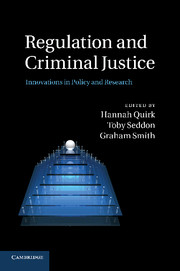Book contents
- Frontmatter
- Contents
- List of figures and tables
- Notes on contributors
- Foreword
- Acknowledgements
- 1 Regulation and criminal justice: exploring the connections and disconnections
- PART I Regulation and criminal justice: framing the debate
- PART II Criminal justice as regulation: responsivity, alternatives and expansion
- 5 Nodal governance and the Zwelethemba Model
- 6 Regulatory compliance: organizational capacities and regulatory strategies for environmental protection
- 7 An intoxicated politics of regulation
- 8 Governing by civil order: towards new frameworks of support, coercion and sanction?
- 9 Counter-terrorism and community relations: anticipatory risk, regulation and justice
- PART III Regulation of criminal justice: monitoring, effectiveness and accountability
- Index
- References
9 - Counter-terrorism and community relations: anticipatory risk, regulation and justice
Published online by Cambridge University Press: 04 February 2011
- Frontmatter
- Contents
- List of figures and tables
- Notes on contributors
- Foreword
- Acknowledgements
- 1 Regulation and criminal justice: exploring the connections and disconnections
- PART I Regulation and criminal justice: framing the debate
- PART II Criminal justice as regulation: responsivity, alternatives and expansion
- 5 Nodal governance and the Zwelethemba Model
- 6 Regulatory compliance: organizational capacities and regulatory strategies for environmental protection
- 7 An intoxicated politics of regulation
- 8 Governing by civil order: towards new frameworks of support, coercion and sanction?
- 9 Counter-terrorism and community relations: anticipatory risk, regulation and justice
- PART III Regulation of criminal justice: monitoring, effectiveness and accountability
- Index
- References
Summary
Introduction
Since the 9/11 attacks in Washington and New York, national security issues have risen sharply up the political agenda in many western nation states (see Amoore and de Goede 2008; McGhee 2008; Vedby Rasmussen 2008; Zedner 2005). Post-9/11 a cluster of incidents, including bombings in Istanbul, the Madrid train explosions and the 7/7 attacks in London have fixed the terrorist risk as a critical social concern. Despite the fact that political violence is a historically omnipresent phenomenon, the attacks committed by supporters of al-Qaeda have reconfigured not just the perceived level of the threat in the UK but also the scope of legal measures taken to tackle terrorism (see Bonner 2008; Lambert 2008). In recent years, terrorism has become ubiquitous in political and media discourse, being emblematic of the fears and uncertainties that characterize the ‘risk society’ (see Beck 2009; Mythen 2008). Of course, it is easy to see why ‘global’ terrorism has become such a focal issue. Not only are international terrorist attacks unpredictable and sizeable in scale, they effectively disrobe the claim that the state is able to secure safety and security for its citizens.
The regulatory responses to 9/11 and 7/7 have had wide-ranging impacts on Muslims living in the UK. Following on from these incidents, Muslim minority groups have been subject to intensified modes of monitoring, surveillance and intervention by crime and security agencies.
- Type
- Chapter
- Information
- Regulation and Criminal JusticeInnovations in Policy and Research, pp. 211 - 234Publisher: Cambridge University PressPrint publication year: 2010



